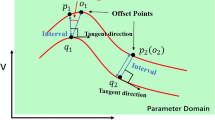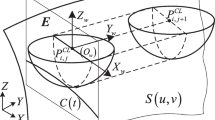Abstract
Shortening total length of tool path is preferred in numerical control (NC) machining since it can reduce machining time effectively. Compared with iso-planar tool path, iso-scallop tool path is shorter in length due to the pursuing of maximum interval values. However, the process of iso-scallop tool path generation is more complicated and time-consuming. To simplify the computing process and improve efficiency, this paper presents an efficient iso-scallop tool path generation method for three-axis scattered point cloud machining. Avoiding offsetting points or fitting surface, scallop points and iso-scallop cutter location (CL) points are directly calculated based on scattered data points by iterative algorithms. In order to reduce the times of iterative calculations, initial scallop-height points and CL points are calculated to be closer to the wanted theoretical points. Only a small number of key data points are searched for use so as to reduce calculation amount, and the number gradually decreases with the increase of iterations. Two typical point clouds are used to test the presented method. The experiment results indicate that the scallop height on the machined surface is uniform, and total length of the generated tool paths is much shorter than that of iso-planar tool paths. Moreover, the computation efficiency is also improved and is higher than our previous method (Int J Adv Manuf Technol 63: 137–146, 2012).


















Similar content being viewed by others
References
Lin AC, Liu HT (1998) Automation generation of NC cutter path from massive data points. Comput Aided Des 30(1):77–90
Park SC, Chung YC (2003) Tool-path generation from measured data. Comput Aided Des 35(5):467–475
Zhang YJ, Ge LL (2011) Adaptive tool-path generation on point-sampled surfaces. Precis Eng 35(4):591–601
Zhang DD, Yang PH, Qian XP (2009) Adaptive NC path generation from massive point data with bounded error. J Manuf Sci Eng 131(1):011001
Yau HT, Hsu CY (2009) Generating NC tool paths from random scanned data using point-based models. Int J Adv Manuf Technol 41(9–10):897–907
Zou Q, Zhao JB (2013) Iso-parametric tool-path planning for point clouds. Comput Aided Des 45(11):1459–1468
Chui KL, Chiu WK, Yu KM (2008) Direct 5-axis tool-path generation from point cloud input using 3D biarc fitting. Robot Cim-Int Manuf 24(2):270–286
Liu W, Zhang JW, Zhu SM, Zhang CC, Yuan TJ (2017) Efficient tool posture global collision-free area generation for 5-axis point clouds machining. Int J Adv Manuf Technol 88(1–4):1013–1023
Liu W, Zhang JW, Cao ZY, Zhu SM, Yuan TJ (2016) Direct 5-axis tool posture local collision-free area generation for point clouds. Int J Adv Manuf Technol 86(5–8):2055–2067
Hu PC, Chen LF, Tang K (2017) Efficiency-optimal iso-planar tool path generation for five-axis finishing machining of freeform surfaces. Comput Aided Des 83(2):33–50
Suresh K, Yang DCH (1994) Constant scallop-height machining of free-form surfaces. ASME J Eng Ind 116:253–259
Lin RS, Koren Y (1996) Efficient tool-path planning for machining free-form surfaces. ASME J Eng Ind 118:20–28
Feng HY, Li H (2002) Constant scallop-height tool path generation for three-axis sculptured surface machining. Comput Aided Des 34(9):647–654
Yoon JH (2005) Fast tool path generation by the iso-scallop height method for ball-end milling of sculptured surfaces. Int J Prod Res 43(23):4989–4998
Balabokhin A, Tarbutton J (2017) Iso-scallop tool path building algorithm “based on tool performance metric” for generalized cutter and arbitrary milling zones in 3-axis CNC milling of free-form triangular meshed surfaces. J Manuf Process 28(3):565–572
Lee YS (1998) Non-iso parametric tool path planning by machining strip evaluation for 5-axis sculptured surface machining. Comput Aided Des 30(7):559–570
Plakhotnik D, Lauwers B (2012) Computing of the actual shape of removed material for five-axis flat-end milling. Comput Aided Des 44(11):1103–1114
Wu BH, Liang MC, Zhang Y, Luo M, Tang K (2018) Optimization of machining strip width using effective cutting shape of flat-end cutter for five-axis free-form surface machining. Int J Adv Manuf Technol 94(5–8):2623–2633
Can A, Ünüvar A (2010) A novel iso-scallop tool-path generation for efficient five-axis machining of free-form surfaces. Int J Adv Manuf Technol 51(9–12):1083–1098
Min C, Gao XS (2015) Iso-scallop tool-path generation of five-axis computer numerically controlled machining for cyclide splines. P I Mech Eng B-J Eng 229(7):1144–1156
Wang SL, Lin B, Zhang XF, Liang JM, Wang Y (2015) A novel tool path generation algorithm for plane envelope grinding convex surface based on constant scallop height method. Int J Adv Manuf Technol 78(5–8):1087–1099
Lin ZW, Fu JZ, Shen HY, Gan WF (2014) A generic uniform scallop tool path generation method for five-axis machining of freeform surface. Comput Aided Des 56(11):120–132
Senatore J, Moussaoui K, Segonds S, Moniès F, Rubio W (2013) Analysis of drift in iso-scallop planning—machining by regions. Int J Adv Manuf Technol 63(1–4):719–732
Jia ZY, Zhao XX, Ma JW, Chen SY, Qin FZ, Liu Z (2019) Tool path generation in sub-regional processing with constraint of constant scallop-height at boundary for complex curved surface. Precis Eng 55(1):217–230
Wu FZ, Hua XY, Lian JY (2007) Constant scallop-height tool path planning from measured data. J Comput Aided Des Comp Graph 19(12):1618–1623 (in Chinese)
Liu W, Zhou LS, An LL (2012) Constant scallop-height tool path generation for three-axis discrete data points machining. Int J Adv Manuf Technol 63(1–4):137–146
Funding
The research is supported by the Science and Technology Plan Project of Suzhou City (SYG201816), the Graduate Research and Innovation Projects of Jiangsu Province (201410332032Y), and the Graduate Research and Innovation Projects of Suzhou University of Science and Technology.
Author information
Authors and Affiliations
Corresponding author
Additional information
Publisher’s note
Springer Nature remains neutral with regard to jurisdictional claims in published maps and institutional affiliations.
Rights and permissions
About this article
Cite this article
Liu, W., Zhu, SM., Huang, T. et al. An efficient iso-scallop tool path generation method for three-axis scattered point cloud machining. Int J Adv Manuf Technol 107, 3471–3483 (2020). https://doi.org/10.1007/s00170-020-05188-y
Received:
Accepted:
Published:
Issue Date:
DOI: https://doi.org/10.1007/s00170-020-05188-y




